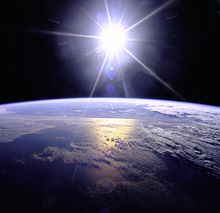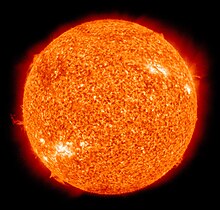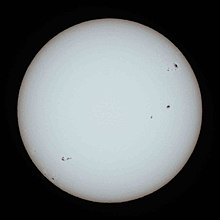Talk:Sun
| This is the talk page for discussing improvements to the Sun article. This is not a forum for general discussion of the article's subject. |
Article policies
|
| Find sources: Google (books · news · scholar · free images · WP refs) · FENS · JSTOR · TWL |
 | Sun is a featured article; it (or a previous version of it) has been identified as one of the best articles produced by the Wikipedia community. Even so, if you can update or improve it, please do so. | |||||||||||||||
| Sun is part of the Solar System series, a featured topic. This is identified as among the best series of articles produced by the Wikipedia community. If you can update or improve it, please do so. | ||||||||||||||||
| This article appeared on Wikipedia's Main Page as Today's featured article on March 20, 2006. | ||||||||||||||||
| ||||||||||||||||
| Current status: Featured article | ||||||||||||||||
| This article is of interest to the following WikiProjects: | ||||||||||||||||||||||||||||||||||||||||||||||
| ||||||||||||||||||||||||||||||||||||||||||||||
|
||||||||||
|
This page has archives. Sections older than 90 days may be automatically archived by Lowercase sigmabot III when more than 5 sections are present. |
Edit request- "atmosphere" section
In the atmosphere section 5.6, the extend of the heliosphere should be rather more than 100AU. See and maybe add reference to Voyager heliopause crossing (debate): http://iopscience.iop.org/article/10.1088/1742-6596/577/1/012011/meta cf. two sentences later in the section the sun has circled the galaxy 19.9 times
Infobox image(s)
 Sun as seen in visible light. | |
 Sun as seen in ultraviolet light (wavelength of 30.4 nm). | |
| Observation data | |
|---|---|
| Mean distance from Earth | [etc] |
I propose that the article's infobox has at least 2 images, possibly that readers can view one at a time using tabs.
As we can see when watching the films Guardian of the Galaxy (when the planet Xandar is introduced) and Passengers, many people have the idea that stars when viewed with naked eyes resemble a giant ball of fire, which is what the Sun resembles when when viewed using ultraviolet photography. I suspect that the reason for this misconception is that their impression of the Sun comes from its ultraviolet photograph, not its visible light photograph.
To the right is the infobox with my suggested photos. VarunSoon (talk) 07:24, 23 January 2019 (UTC)
- I disagree with this change. The image on the left in the revised infobox is almost useless as a picture of the Sun. Most of the area in the image is taken up by either blank empty space or the Earth, and the face of the Sun itself is not even seen in the picture: all that's seen is saturated glare and lens flare, which obscures the actual content that should be shown in an infobox image which should show the Sun itself. I would propose two possible solutions. (1) revert back to the previous image, but add the UV image somewhere in the article where it will still be useful. (2) If there is a general preference to have 2 images, remove the image on the left and replace it with the previous visible-light image of the Sun which shows the Sun's actual photospheric appearance at visible wavelengths. Aldebarium (talk) 16:22, 4 February 2019 (UTC)
- Yes, it was better before. The oversaturated sunburst image is not a good selection for an image of the sun. I would be fine with a double image of the visible and UV images per the collapsed box below:
Suggested infobox images
| ||||||||
|---|---|---|---|---|---|---|---|---|
| ||||||||
VQuakr (talk) 20:21, 4 February 2019 (UTC)
- @VQuakr:, @Aldebarium:
- But still, shouldn't we answer a reader's question 'if I were to go into space, and look (indirectly) in the direction of the sun with my naked eyes, what would I see?'? Canopus, Alpha Centauri and Alcyone (star) have a visible light photo as their infobox image.
- The misconception is widely held enough that if one google for an image of the word 'sun,' about half of the images that show up are the UV photographs, and that NASA uses the UV photo as the top photo for this page. Other pages include this. Wikipedia, being an encyclopedia, ought to correct this misconception and not create any new one.
- If we use two images, is it better to stack them or put them side-by-side?
VarunSoon (talk) 00:23, 5 February 2019 (UTC)
- The visible light image that was in the infobox originally is pretty much what you would actually see, if you could view the Sun safely. For example if you use eclipse glasses to look at the Sun safely, or a telescope with a solar filter, that's what you will see: the Solar photosphere, sometimes with sunspots. The image you chose of the Sun as seen from space shows a bright glare because the Sun itself is completely saturated in the image, and there's a lot of scattered light and lens flare from the camera optics, which make it impossible to see the Sun's actual shape in that picture: instead all you see is the glare and scattered light from the camera optics, surrounding a totally saturated bright core. The misconception (if there is one at all) is a misconception that the Sun's appearance in visible light has rays and lens flare coming out of it. That stuff is not part of the Sun, that's just what the camera optics are doing. Aldebarium (talk) 00:42, 5 February 2019 (UTC)
- The version with the status quo image, [1], shows a white sun. It is accurate to what you would see either from space or from earth looking at the sun in the visible spectrum. An image of lens flare is not a better choice for the lead image per MOS:IMAGERELEVANCE. If we want two images, I think they looked better stacked vertically. VQuakr (talk) 04:27, 5 February 2019 (UTC)
- I want two images per your suggestion (the filtered one and the UV one placed below it). I want the misconception perpetuated by the UV photos to be dispelled. I want people to be able to visit this article and come out realizing that the the depiction of stars in the films Guardian of the Galaxy and Passengers was as inaccurate as the asteroid field in The Empire Strikes Back. I think the UV photos are used over the filtered visible light photos by NASA because of aesthetic reason. VarunSoon (talk) 05:11, 5 February 2019 (UTC)
@Aldebarium: Do we have a consensus here (at least among us three) about the infobox image(s)? My current position is for the status quo filtered one on top and the UV one below it (for the purpose of correcting the widely held misconception about what stars look like). VarunSoon (talk) 05:30, 6 February 2019 (UTC)
- That seems reasonable to me. It will definitely be good to include the UV image in the article. I don't have a strong opinion as to whether it should be in the infobox or somewhere else in the article, but I do agree that it will be useful and informative to include it somewhere. Aldebarium (talk) 05:44, 7 February 2019 (UTC)
~74% of the Sun's elemental mass is Hydrogen revisited
The article appears to say that the proportion of helium in the sun has fallen despite the fusion of hydrogen into helium in the sun.
From the Composition section of the Sun page:
"The Sun is composed primarily of the chemical elements hydrogen and helium. At this time in the Sun's life, they account for 74.9% and 23.8% of the mass of the Sun in the photosphere, respectively. ... Originally it would have contained about 71.1% hydrogen, 27.4% helium, and 1.5% heavier elements ... Since the Sun formed, the main fusion process has involved fusing hydrogen into helium."
Careful reading and a comment on the Talk page suggest that the second number refers to the total mass of the sun, and the first to the composition of the photosphere, however this is not immediately obvious. Ideally, comparable figures would be added that both refer to either the total mass, or the photosphere. That would give readers an idea of the changes over time. If these numbers aren't available then the text could be reworded to highlight the change of context.
Slewins (talk) 11:12, 8 February 2019 (UTC)
- Some helium has settled to the center over the Sun's lifetime. This accounts for the decreasing abundance in the photosphere. Ruslik_Zero 13:33, 28 March 2019 (UTC)
Semi-protected edit request on 16 April 2019
This edit request has been answered. Set the |answered= or |ans= parameter to no to reactivate your request. |
The sun surface temperature is not 5,778 but 5,772. ( NASA Official Number ) 94.241.227.0 (talk) 21:00, 16 April 2019 (UTC)
 Not done. A few degrees at that scale is meaningless. –Deacon Vorbis (carbon • videos) 21:35, 16 April 2019 (UTC)
Not done. A few degrees at that scale is meaningless. –Deacon Vorbis (carbon • videos) 21:35, 16 April 2019 (UTC)
Poor quality...
In the "Name and etymology" section:
"A mean Earth solar day is approximately 24 hours, whereas a mean Martian 'sol' is 24 hours, 39 minutes, and 35.244 seconds.[26]"
- really? We know the precise length of a Martian 'sol' but not that of the Earth's 'solar day'? Aside from the variance in literal terms ('sol' vs 'solar day'), why is one value so precise and the other so vague? --> 10 points for Entertainment Value. 99.4.120.135 (talk) 17:44, 24 April 2019 (UTC)
- I deleted the offending sentence, which is (after all) not relevant to the Sun itself, or to its etymology. The prior sentence about planetary astronomers using "sol" for a planetary day serves the same purpose. zowie (talk) 18:35, 24 April 2019 (UTC)
- Thank you. 99.4.120.135 (talk) 20:05, 25 April 2019 (UTC)
Longevity fix in science fiction
A boomerang-like (or other shape) man-made meteorite built of a material which will melt relatively slowly (as it enters the sun) (... due to magnetic repulsion "?") will stir fresher gas to expand sun's lifespan. (of course that's impossible, or insanely expensive)
- Wikipedia featured articles
- FA-Class Featured topics articles
- Wikipedia featured topics Solar System featured content
- High-importance Featured topics articles
- Featured articles that have appeared on the main page
- Featured articles that have appeared on the main page once
- FA-Class physics articles
- Top-importance physics articles
- FA-Class physics articles of Top-importance
- FA-Class Astronomy articles
- Top-importance Astronomy articles
- FA-Class Astronomy articles of Top-importance
- FA-Class Astronomical objects articles
- Pages within the scope of WikiProject Astronomical objects (WP Astronomy Banner)
- Unassessed Astronomy articles
- Unknown-importance Astronomy articles
- Unassessed Astronomy articles of Unknown-importance
- Unassessed Solar System articles
- Unknown-importance Solar System articles
- Solar System task force
- Pages using WikiProject banner shell with duplicate banner templates





